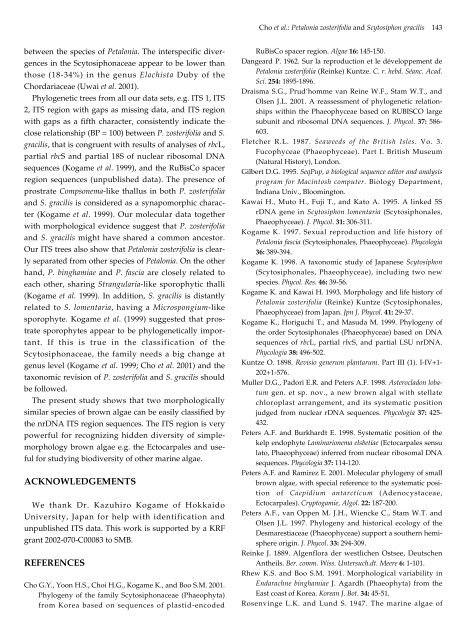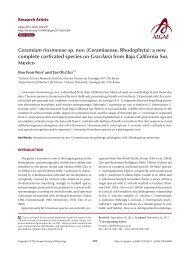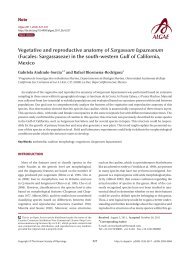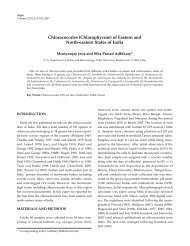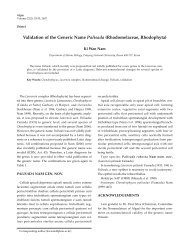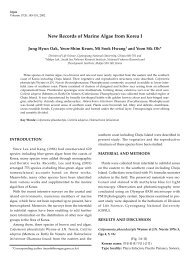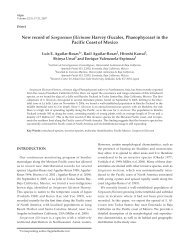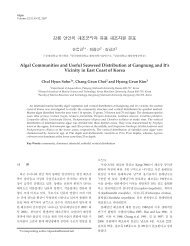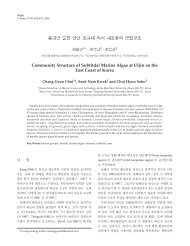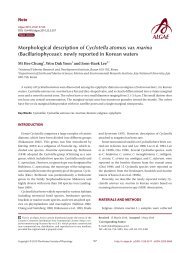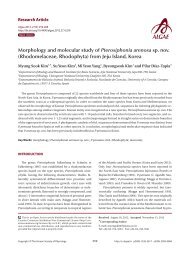First Description of Petalonia zosterifolia and Scytosiphon ... - Algae
First Description of Petalonia zosterifolia and Scytosiphon ... - Algae
First Description of Petalonia zosterifolia and Scytosiphon ... - Algae
You also want an ePaper? Increase the reach of your titles
YUMPU automatically turns print PDFs into web optimized ePapers that Google loves.
Cho et al.: <strong>Petalonia</strong> <strong>zosterifolia</strong> <strong>and</strong> <strong>Scytosiphon</strong> gracilis 143between the species <strong>of</strong> <strong>Petalonia</strong>. The interspecific divergencesin the <strong>Scytosiphon</strong>aceae appear to be lower thanthose (18-34%) in the genus Elachista Duby <strong>of</strong> theChordariaceae (Uwai et al. 2001).Phylogenetic trees from all our data sets, e.g. ITS 1, ITS2, ITS region with gaps as missing data, <strong>and</strong> ITS regionwith gaps as a fifth character, consistently indicate theclose relationship (BP = 100) between P. <strong>zosterifolia</strong> <strong>and</strong> S.gracilis, that is congruent with results <strong>of</strong> analyses <strong>of</strong> rbcL,partial rbcS <strong>and</strong> partial 18S <strong>of</strong> nuclear ribosomal DNAsequences (Kogame et al. 1999), <strong>and</strong> the RuBisCo spacerregion sequences (unpublished data). The presence <strong>of</strong>prostrate Compsonema-like thallus in both P. <strong>zosterifolia</strong><strong>and</strong> S. gracilis is considered as a synapomorphic character(Kogame et al. 1999). Our molecular data togetherwith morphological evidence suggest that P. <strong>zosterifolia</strong><strong>and</strong> S. gracilis might have shared a common ancestor.Our ITS trees also show that <strong>Petalonia</strong> <strong>zosterifolia</strong> is clearlyseparated from other species <strong>of</strong> <strong>Petalonia</strong>. On the otherh<strong>and</strong>, P. binghamiae <strong>and</strong> P. fascia are closely related toeach other, sharing Strangularia-like sporophytic thalli(Kogame et al. 1999). In addition, S. gracilis is distantlyrelated to S. lomentaria, having a Microspongium-likesporophyte. Kogame et al. (1999) suggested that prostratesporophytes appear to be phylogenetically important.If this is true in the classification <strong>of</strong> the<strong>Scytosiphon</strong>aceae, the family needs a big change atgenus level (Kogame et al. 1999; Cho et al. 2001) <strong>and</strong> thetaxonomic revision <strong>of</strong> P. <strong>zosterifolia</strong> <strong>and</strong> S. gracilis shouldbe followed.The present study shows that two morphologicallysimilar species <strong>of</strong> brown algae can be easily classified bythe nrDNA ITS region sequences. The ITS region is verypowerful for recognizing hidden diversity <strong>of</strong> simplemorphologybrown algae e.g. the Ectocarpales <strong>and</strong> usefulfor studying biodiversity <strong>of</strong> other marine algae.ACKNOWLEDGEMENTSWe thank Dr. Kazuhiro Kogame <strong>of</strong> HokkaidoUniversity, Japan for help with identification <strong>and</strong>unpublished ITS data. This work is supported by a KRFgrant 2002-070-C00083 to SMB.REFERENCESCho G.Y., Yoon H.S., Choi H.G., Kogame K., <strong>and</strong> Boo S.M. 2001.Phylogeny <strong>of</strong> the family <strong>Scytosiphon</strong>aceae (Phaeophyta)from Korea based on sequences <strong>of</strong> plastid-encodedRuBisCo spacer region. <strong>Algae</strong> 16: 145-150.Dangeard P. 1962. Sur la reproduction et le développement de<strong>Petalonia</strong> <strong>zosterifolia</strong> (Reinke) Kuntze. C. r. hebd. Séanc. Acad.Sci. 254: 1895-1896.Draisma S.G., Prud’homme van Reine W.F., Stam W.T., <strong>and</strong>Olsen J.L. 2001. A reassessment <strong>of</strong> phylogenetic relationshipswithin the Phaeophyceae based on RUBISCO largesubunit <strong>and</strong> ribosomal DNA sequences. J. Phycol. 37: 586-603.Fletcher R.L. 1987. Seaweeds <strong>of</strong> the British Isles. Vo. 3.Fucophyceae (Phaeophyceae). Part I. British Museum(Natural History), London.Gilbert D.G. 1995. SeqPup, a biological sequence editor <strong>and</strong> analysisprogram for Macintosh computer. Biology Department,Indiana Univ., Bloomington.Kawai H., Muto H., Fuji T., <strong>and</strong> Kato A. 1995. A linked 5SrDNA gene in <strong>Scytosiphon</strong> lomentaria (<strong>Scytosiphon</strong>ales,Phaeophyceae). J. Phycol. 31: 306-311.Kogame K. 1997. Sexual reproduction <strong>and</strong> life history <strong>of</strong><strong>Petalonia</strong> fascia (<strong>Scytosiphon</strong>ales, Phaeophyceae). Phycologia36: 389-394.Kogame K. 1998. A taxonomic study <strong>of</strong> Japanese <strong>Scytosiphon</strong>(<strong>Scytosiphon</strong>ales, Phaeophyceae), including two newspecies. Phycol. Res. 46: 39-56.Kogame K. <strong>and</strong> Kawai H. 1993. Morphology <strong>and</strong> life history <strong>of</strong><strong>Petalonia</strong> <strong>zosterifolia</strong> (Reinke) Kuntze (<strong>Scytosiphon</strong>ales,Phaeophyceae) from Japan. Jpn J. Phycol. 41: 29-37.Kogame K., Horiguchi T., <strong>and</strong> Masuda M. 1999. Phylogeny <strong>of</strong>the order <strong>Scytosiphon</strong>ales (Phaeophyceae) based on DNAsequences <strong>of</strong> rbcL, partial rbcS, <strong>and</strong> partial LSU nrDNA.Phycologia 38: 496-502.Kuntze O. 1898. Revisio generum plantarum. Part III (1). I-IV+1-202+1-576.Muller D.G., Padori E.R. <strong>and</strong> Peters A.F. 1998. Asterocladon lobatumgen. et sp. nov., a new brown algal with stellatechloroplast arrangement, <strong>and</strong> its systematic positionjudged from nuclear rDNA sequences. Phycologia 37: 425-432.Peters A.F. <strong>and</strong> Burkhardt E. 1998. Systematic position <strong>of</strong> thekelp endophyte Laminarionema elsbetiae (Ectocarpales sensulato, Phaeophyceae) inferred from nuclear ribosomal DNAsequences. Phycologia 37: 114-120.Peters A.F. <strong>and</strong> Ramirez E. 2001. Molecular phylogeny <strong>of</strong> smallbrown algae, with special reference to the systematic position<strong>of</strong> Caepidium antarcticum (Adenocystaceae,Ectocarpales). Cryptogamie, Algol. 22: 187-200.Peters A.F., van Oppen M. J.H., Wiencke C., Stam W.T. <strong>and</strong>Olsen J.L. 1997. Phylogeny <strong>and</strong> historical ecology <strong>of</strong> theDesmarestiaceae (Phaeophyceae) support a southern hemisphereorigin. J. Phycol. 33: 294-309.Reinke J. 1889. Algenflora der westlichen Ostsee, DeutschenAntheils. Ber. comm. Wiss. Untersuch.dt. Meere 6: 1-101.Rhew K.S. <strong>and</strong> Boo S.M. 1991. Morphological variability inEndarachne binghamiae J. Agardh (Phaeophyta) from theEast coast <strong>of</strong> Korea. Korean J. Bot. 34: 45-51.Rosenvinge L.K. <strong>and</strong> Lund S. 1947. The marine algae <strong>of</strong>


